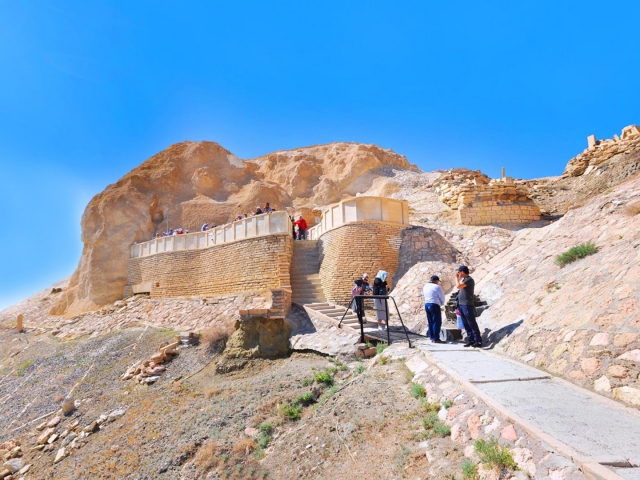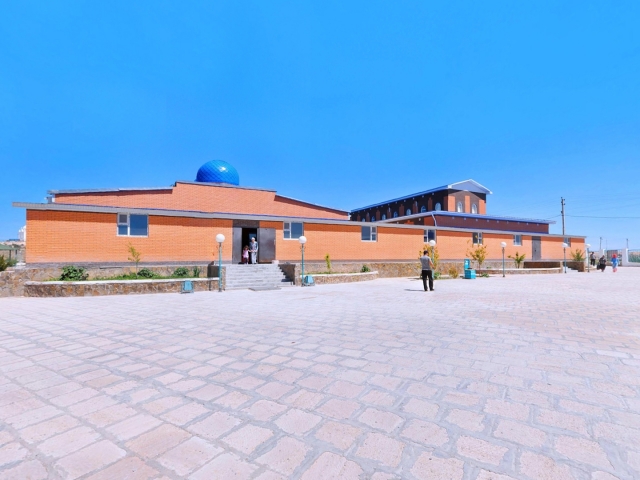Places
List of objects included in the map
Becket-Ata Underground Mosque in Oglandy (18th-19th centuries)
Location: Located in Karakiyan district, Mangistau region, 95 km to the north-east from Senek village.
Coordinates: N 43°35' 45.91" , E 54°4' 34.21"
Description of the Monument: The monument was first investigated in 1973 by expedition of the society for protection of historical and cultural monuments under the direction of M. Mendikulov. In 1979 it was studied by a group of architects from 'Kazproektrestavratsiya' Institute headed by M.S. Nurkabaev. The monument was first taken under the state protection upon Resolution no. 38 of the Council of Ministers of the Kazakh SSR dated 26.01.1982, with amendments and additions; in accordance with the Decree of the Prime Minister of the Republic of Kazakhstan no. 897 dated 16.05.2000 changed its local status to the republican. By Order of the Minister of Culture and Sports of the Republic of Kazakhstan no. 119 dated March 30, 2015 the memorial was included in the governmental list of historical and cultural monuments of national importance. Order no. 209 of Mangistau Regional Akimat dated September 3, 2014 approved the boundaries of protected zones of underground mosque Becket-Ata, in Oglandy area Karakiyan district. In 1996, 2000, 2003, 2006, 2010 'Mangyshlakrestavracija' institute did scientific and restoration works, a big mosque for pilgrims was built. In 2016 specialists of state enterprise 'Kazrestavratsiya' did the research in order to determine technical conditions and thermal and humidity conditions in Becket-Ata mosque. This memorial was included into the list of sacred objects as part of the project of regional importance Geography of Sacral Paces in Kazakhstan within the program 'Spiritual Renewal'. The mosque is carved in the middle tier of a high cliff, descending into a deep ravine overgrown with bushes. The mosque consists of four premises. The first room is the lobby, illuminated with a skylight made in the center of the domed ceiling. There is a wooden pole. On the west side of the lobby there is a prayer hall with the mihrab in the southern wall and on the south-east there are two rooms with Becket Ata buried in one of them. He died at the age of 63 years. All the rooms have the shape of an irregular circle. Their height ranges from 2.7 to 3.5 m. Walls with multiple flat lamp niches are smoothly chipped.
Historical Data, Legends and Stories: Becket Myrzagululy (1750-1813) was a philosopher and educator, descendant of Aday, inhabiting the Ustyurt and Mangistau, and Atyrau. Born in Akmeshit village, Zhiloy district in Atyrau region. According to legends passed from father to son Becket-Ata was the batyr who struggled with enemies for people's independence. He was a mentor who know the path of science and education in the regions of Mangistau, Atyrau and Ustyurt. Becket-Ata was a master architect; he built a madrasah and a mosque, and an underground mosque for teaching children; he was also a healer, who had mastered the power of nature and put sick people on their feet. For bravery and courage in battles with the Kalmyks and Turkmen, Becket Ata is popularly called Batyr. According to a legend, Once in his childhood he was walking over a river and saw a finger sticking out of the water.. After that forty fingers appeared from the water. The young man saw ayan in this (prophetic sign), and realized that supreme power let him know that he should take the path of religion (five fingers are five-time namaz, thirty fingers are thirty day sawm, forty fingers are forty commandments). Since that moment Becket Ata stepped the true path of religion. Having been trained in Khiva by the famous Sufi Bakyrgan-Kazhy, Becket returned his homeland and continued his works among his fellow tribesmen. He built underground mosques, organized education of children, preached service of God through his personal example. For extraordinary powers this amazing man to heal the soul and the body to protect are in trouble and send in doubt, when life was considered sacred. During his life he constructed a number of mosques in places of seasonal migration of his tribe. It is Akmechet in Atyrau region, in the area of Tobykty, in Old Beineu, Oglandy and Baishagyr. 'Ogylandy' is translated from Turkmen as infant, kid. According to the legend, in one year nomadic Turkmen tribes lost many children here due to epidemic. All of them were buried at the same cemetery, which was later called Oglandy, that is for children. During his life Becket Ata willed that the pilgrims before making a bow to him should visit this place considered sacred by locals. The flow of worshippers willing to get healed and comforted does not get thinner. At present Becket-Ata mosque is restored, the area around it is well-arranged; on top of the plateau there is a large complex for numerous pilgrims who continuously flock to the holy place. It is a holy place of the same range as burial places of Mohammed and Khoja Ahmed Yassaui.
Sources:
- Encyclopedia 'Aibyn'.
Editor in chief B. O. Zhakyp. Almaty: 'Kazakh encyclopedia', 2011 – 880 pages;
- 'Historical Figures'
(educational and popular edition). For students and public. Authors: B. Togysbayeva,
A. Suzhikova. 'Almaty Publishing House', 2009;
- Atyrau: Encyclopedia.
Almaty: Atamura, 2000;
- Islam. Encyclopedic
reference. Almaty: "Aruna Ltd.' LLP, 2010;
- 'Alashtyn Ardagy' (a
collection on country studies and
linguistics). Authors E. E. Tileshov, G. P. Aripbek. Astana: 'Rukhaniyat',
2010;
- 'The Sufi
Path of Becket Ata' B. Abdirakhmanov. Almaty: Nurly Alem, 2010;
- Archives of Mangystau
National Historical and Cultural Reserve, archive fund no. 209 (monument
Passport).
Views: 3905
Video
3D Модель
Маршрут
Hazret Yerzhan Burial
Shopan Ata Necropolis and Underground Mosque
Shakpak Ata Necropolis and Underground Mosque (14th–19th centuries)
Khatam-Ishan Mausoleum
The earliest structures here date back to the second half of the 17th c. The necropolis was developed in time and space in a circle, i.e. the most ancient constructions remained in the center. Out of the two extant domed mausoleums, the structure in the southern part of the necropolis is of particular interest. ...






















